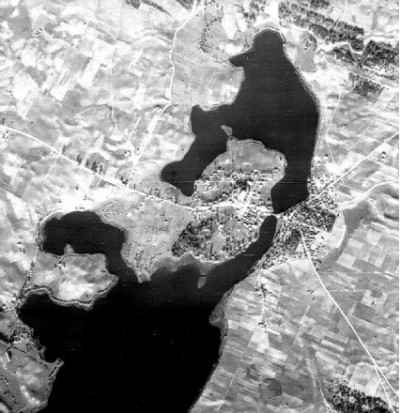 |
Photo supplied by Barney Rubin
|
|
[Page 612]
Veisiejai, Lithuania
54°06' 23°42'
Vishey (in Yiddish) is situated in the southern part of Lithuania, close to the Polish border. The town was built along the shores of Lake Ancia (pronounced Ancha) where a bridge connects the two parts, with many woods and lakes in its surroundings. The district administrative capitol Lazdey is about 20 km distance from Vishey.
Vishey was founded during the first half of the sixteenth century near the estate of the Lithuanian Prince Glinsky, after King Zigmund “The Old” permitted the establishment of a bar room near the estate and to maintain markets.
|
|
|
Aerial photo from Vishey taken by the German Luftwaffe in 1944 Photo supplied by Barney Rubin |
[Page 613]
|
|
| Vishey from the air |
Until 1795 Vishey was part of the Polish–Lithuanian Kingdom, after which the third division of Poland by the three superpowers of those times – Russia, Prussia and Austria – resulted in Lithuania becoming partly Russian and partly Prussian. The part of the state which lay on the left side of the Nieman river (Nemunas), including Vishey, was handed over to Prussia which ruled there during the years 1795–1807, Vishey being a county administrative center during these years.
[Page 614]
After Napoleon defeated Prussia and according to the Tilzit agreement of July 1807, Polish territories occupied by Prussia were transferred to what became known as the “The Great Dukedom of Warsaw”, which was established at that time. The King of Saxony, Friedrich–August, was appointed Duke, and the Napoleonic code now became the constitution of the Dukedom, according to which everybody was equal before the law, except for the Jews who were not granted any civil rights.
During the years 1807–1813, Vishey belonged to the “Great Dukedom of Warsaw” and was part of the Bialystok district. The Napoleonic code was then introduced in this region, remaining in effect even during the Lithuanian period. In 1827 Vishey had a population of 737 people.
In 1815, after the defeat of Napoleon, all of Lithuania was annexed to Russia, as a result of which Vishey was included in the Augustowa Province (Gubernia), and in 1866 it became a part of the Suwalk Gubernia as a county administrative center.
Jewish Settlement till World War II
Apparently Jews started to settle in Vishey in the middle of the eighteenth century after the Great Hetman Masalsky, the owner of the estate at this time, invited them there in order to promote commerce. Jewish merchants would buy grain and other agricultural products in the surroundings, transport them to Grodno and in return import industrial goods from there. A document of 1783 in possession of the Vishey church states that several tens of Jewish families were living there after getting permission to do so from Bishop Zienkewitz of Vilna in 1748. They had their synagogue and a “Kahal”. In 1797 there were 518 people and 85 houses in Vishey.
In November 1811 the Russian finance minister Matushevitz invited Jewish representatives from all ten Gubernias of Poland to a meeting in order to discuss the issues of taxes and of military service of Jewish youth. The representative of Lomzha Gubernia was Sender Abramovitz from Vishey.
In the 1870s century many Lithuanian Jews immigrated to America. In a list of immigrants from 1869/70 the name of A.Miler from Vishey was found.
By 1897 the population of Vishey numbered 1,540 people, of whom 974 were Jews (63%), who made their living from commerce, crafts, fishing and agriculture, with several Jewish families owning great estates. In those days the economic situation of Vishey Jews was sound, but the large fire of 1872 badly affected the economy for many years to come. In this same year Vishey Jews donated money for the hungry, the collectors being Eliyahu Kaplovsky, Dr.Shemuel Kukliansky and Aba–Leib Tuman.
In 1891 a “School for Boys” was opened, supervised by the local Rabbi Nathan–Neta Kabak and the learned Ben–Zion Rastokhotsky. Russian was also taught and the teachers were M.P.Vainshtein and Sh.Izersky. Before World War I a “Kheder Metukan” (an improved Kheder) was established by David Boyarsky, one of its teachers being the known writer A.A.Kabak.
[Page 615]
During 1886–87 Dr.Ludvig–Lazar Zamenhof lived there, where he worked professionally as an optometrist and created the International Language Esperanto.
|
|
|
“In this place stood the house in which in 1886–1887 lived and worked the creator of the Esperanto language Ludvig Zamenhof” The designer of this monument was V.Margelis |
Long before the “Khibath Zion” movement spread among the Jewish communities of Russia, single Jews from Vishey immigrated to Eretz Yisrael. At least two tombstones of Vishey Jews were found in the old cemetery of Jerusalem: Etl daughter of Avraham, died in 1879, and Ya'akov–Yehoshua Beharav Tsevi grandson of “Peney Yehoshua” (the famous book of Rabbi Ya'akov–Yehoshua Falk, 1680–1756), who died in 1885.
Zionist activity started at the end of the nineteenth century when a “Zionist Association” was established. In 1899 Vishey Zionists were in contact with the Zionist Center in Kishinev, which was in touch with all “Zionist Associations”
[Page 616]
in Russia. In 1899 and 1903, lists of donors from Vishey for “The Settlement of Eretz Yisrael” were published in the Hebrew periodicals of these times. The collector was Dan Yeshaya Cohen. The “Bund” organization also held a strong position in the town till World War I.
During World War I, on the first of April 1915, Vishey Jews, numbering some 400, were exiled, at the order of the retreating Russian army. After the war and the establishment of the Lithuanian state, only half of them returned.
During the Period of Independent Lithuania (1918–1940)
After the war the returning Vishey Jews, who found their property plundered and most of their houses ruined, had to start life anew.
Z.Pitler from Vishey fought as a volunteer for the independence of Lithuania.
According to the Autonomy Law for minorities issued by the new Lithuanian government, the minister for Jewish affairs Dr. Max Soloveitshik ordered, in the summer of 1919, that elections be held for Community Committees in all towns of the state, and such a Committee was also elected in Vishey. It was active till the end of 1925 when the autonomy was annulled. During its existence the Committee collected taxes as required by law and was in charge of almost all aspects of community life, mainly the registration of births, marriages and deaths. These registration books were badly damaged in a fire in 1924, the remains being stored in the YIVO archives in N.Y. In this fire the synagogue, the school and many other buildings were ruined.
According to the first census performed by the Lithuanian government in 1923, Vishey had a population of 1,295 people, including 516 Jews (40%).
During this period Vishey Jews made their living from commerce, crafts, agriculture and fishing. According to the government survey of 1931 there were 15 shops, 12 of them owned by Jews (80%), consisting of 4 textile shops, 2 butchers, 2 restaurants, 1 shoe shop, 1 sewing machine shop, 1 iron and tools shop (Fridman) and 1 pharmacy (Shaul Kukliansky). There were about ten ”shops of small goods” as written on the boards above the entrances. Since everybody had to work and earn money, these shops were managed by family members of the craftsmen, who sold kerosene, salt, sugar, flour, herring, haberdashery and other goods. The larger shops owned by Leib Flaxman, Benjamin Hasan and Mote Miller, sold manufactured articles.
According to the same survey there were 9 workshops, of them 7 in Jewish hands (78%): 2 bakeries, 1 brick factory, 1 saw mill, 1 flour mill and power station (M.Miller and son), 1 shoe factory. By 1939 only one of the 4 textile shops were still left and the iron and tools shop did not exist anymore.
In 1937, 23 Jewish artisans, members of the Artisans Association, still worked: 4 tailors (Hayim Doktorsky, Gershon Soloveichik, Mosheh Pshezhorsky), 3 shoemakers (Yankel Doktorsky and his son Faive, Alter Shneider, Shelomoh Levinsky), 3 butchers, 2 bakers (Binyamin Rude, Mikhael Rude), 3
[Page 617]
blacksmiths (Leib Khmilevsky, Leizer Ofchinsky, Orchik Bereznitsky), 2 stitchers (Hirsh Zalman Kviatkovsky, Meir Yosef Ribak), 2 carpenters, 1 oven builder (Avraham Berkman), 1 cord maker (Borovsky), 1 knitter and 1 barber (Avraham Sheinkin). There was also a group of Jewish coachmen (Aharon–Hayim and Zelig Shultz, Yankel–Zalman Khmilevsky, Aizik Pitler, Hayim Baltler, Yerukham Milinarsky), who transported goods from Kovno and nearby towns to Vishey, and fish and agricultural products from it.
In addition to this there was the Zimenman family (Moshe, his son David–Elia and his grandson Aron), builders, who used to build log houses in the surrounding villages. They also rebuilt the synagogue burnt down in the fire of 1924. Yankel Kamerunsky and his son made caps, Velvel Fleisher and Dumblevsky caught fish all their lives, Elkhanan Fridkovsky and Hayim–Leib Pitler managed a fishing business. Motel Frank and Motel Arnberg bought agricultural products (each of them in different periods) for export, Nakhum Shneider made lemonade, and the Lozovskis and the Hofman's cultivated land. Some people used to rent their plots.
There were two Jewish doctors (Kopelman and Rik) and one medic (Berel Kukliansky), but in 1939 only one doctor was left.
Most Jews left agriculture, turning to commerce or crafts instead, but many continued to maintain a small auxiliary farm with a vegetable garden, some fruit trees, a cow or a goat and a chicken run beside their houses. Some continued to catch fish and lobsters from the lake.
|
|
|
The second from left in the first row: Shakhne Bereznitsky (living in Vilna), the sixth–Eliezer Peltin (died in 1999 in Kibbutz Mishmaroth) The first from left in the second row: Zlate Milinarsky (murdered in Katkishke) |
[Page 618]
The Jewish “Folksbank” played an important role in the economic life of the town. It had 116 members in 1929, but by 1939 only 70 remained. Katz was the first director of the bank, followed by Mrs. H.Presman–Bereznitsky. There was also a branch of “The United Company for Credit to Jewish Agrarians”. Vishey had 11 phone owners in 1939, including 5 Jews.
During this period the number of Jews decreased, mainly for economic reasons. Most young people moved to the big cities of the state or immigrated abroad including Eretz Yisrael. The big fires of 1924 and 1929 added to the decrease of the Jewish community.
Jewish children received their elementary education at the Hebrew school of the “Tarbuth” chain, whose headmasters were Hayim Shultz and later Kaplan, with an average of 60 children studying there. Many of its graduates continued their studies at high schools, some of them at the Kovno University, and among them two who graduated with a M.D. degree, named M.Shnaider and Y.Levinson. The latter served as a battalion commander in the medical corps of the Red Army during the war, after which he became professor in the faculty of medicine in Kovno University.
The town had a library of about 700 books in Hebrew and Yiddish, as well as a dramatic circle under the guidance of the barber Avraham Sheinkin.
|
|
|
First line from right: Leah Fridkovsky, Ida Peltin, Eli–Yitshak Frank Second line from right: Hayah Iglovsky, Sarah–Leah Peltin, Sheine Bereznitsky, Hinde Arenberg, Rivkah Khmilevsky, Rivkah Frank |
[Page 619]
|
|
|
First line sitting from right: Rivkah Khmilevsky, Hayah Shimansky, Sarah Yedvabnitsky, Lozovsky Second line from right: Haya Iglovsky, ––––––––, Zlate Milinarsky |
During this period many local Jews belonged to the Zionist movement and all Zionist parties had their adherents. This can be seen in the results of elections for Zionist congresses as detailed in the table below:
| Congress Nr. |
Year | Total Shekalim |
Total Voters |
Labor Party
|
Revisionists | General Zionists
|
Grosmanists | Mizrahi | ||||||
| 16 | 1929 | 42 | 22 | — | 2 | 15 | 5 | — | — | — | ||||
| 17 | 1931 | — | 25 | 4 | 5 | 11 | 4 | — | — | — | ||||
| 18 | 1933 | — | 45 | 42 | — | 2 | — | 1 | — | |||||
| 19 | 1935 | — | 58 | 57 | — | 1 | — | — | — | |||||
| 21 | 1939 | 33 | 32 | 26 | — | 1 | — | 5 | — | |||||
[Page 620]
|
|
|
From right: Esther–Zlate Berznitsky–actor of the Jewish popular theater, Leah Podgorsky |
Collectors for the national funds (KKL and Keren Hayesod) would come from Kovno to Vishey from time to time and would be made very welcome.
Among the Zionist youth organizations were “Gordonia” with 40–50 members (one of the activists was Eliezer Peltin, later in Kibutz Mishmaroth in Israel), “Tseirei Zion”, “HeKhalutz” and the sport organization “Maccabi”.
In the fire of 1872 the “Beth Midrash” was ruined too, but it was rebuilt and served as the religious and public center. Vishey cantors with their choirs were famous in Lithuania and would perform in synagogues in nearby towns.
The fire of 1924 razed the “Beth–Midrash” again and Rabbi Yosef Goldin appealed to former Vishey inhabitants in America for urgent help to rebuild it.
Among the Rabbis who served in Vishey were: Eliyahu Margalioth; Nathan–Neta–Klonimus Kabak (1854–1913),in Vishey from 1890; Nakhman Kolyaditsky; Avraham Reznik, who was a delegate to the communities conference in 1920; Yosef Goldin, and the last Rabbi of Vishey was Yekhezkel Goldshlak. These last two were murdered in the Holocaust.
[Page 621]
|
|
|
Members of these organizations were helpful in collecting donations for KKL. There was a “Volunteer Fire Brigade”, most of its members being Jewish, who also maintained a wind orchestra. |
|
|
|
Benyamin Rud–commander of the Jewish Volunteer Fire Brigade and amateur actor Photo supplied by Y. Bereznitsky |
[Page 622]
|
|
|
First line below from right: Mikhal Rud, Yosef Upnitsky, Faivel Doktorsky Second line from right: Alter Shliakhtsitz, Hirsh–Zalmen Kviatkovsky, Balkosatsky, Mosheh Shnaider, the conductor, –––––––, Podgorsky, Yakov Bereznitsky Third line from right: –––––, ––––––, –––––, Mosheh Fridman, Avraham Pitler |
Among the personalities who lived in Vishey were: Mordehai Smolnik, who served as the “Shamash” (synagogue beadle) and who was very conversant with the “Talmud”; Menakhem Diskin, philanthropist and public worker; Shlomo Hirshel, the veteran “Melamed” in town, and A.A.Kabak, (1883–1944) the son of the Rabbi. The latter, who lived in Eretz Yisrael from 1911, was a writer and translator, who published many novels and stories in Hebrew and translated novels from world literature into Hebrew.
[Page 623]
During World War II and afterwards
World War II started with the German invasion of Poland on the 1st of September 1939, and its consequences for Lithuanian Jews in general and Vishey Jews in particular were felt several months later.
In agreement with the Ribbentrop–Molotov treaty on the division of occupied Poland, the Russians occupied the Suvalk region, but after delineation of exact borders between Russia and Germany the Suvalk region fell into German hands. The retreating Russians allowed anyone who wanted to join them to move into their occupied territory, and indeed many young people left the area together with the Russians. The Germans drove the remaining Jews out of their homes in Suvalk and its vicinity, robbed them of their possessions, then directed them to the Lithuanian border, where they were left in dire poverty. The Lithuanians did not allow them to enter Lithuania and the Germans did not allow them to return. Thus they stayed in this swampy area in cold and rain for several weeks, until Jewish youths from the border villages smuggled them into Lithuania by various routes, with much risk to themselves. Altogether about 2,400 refugees passed through the border or infiltrated on their own, and were then dispersed in the “Suvalkiya” region.
In 1940 Lithuania was annexed by the Soviet Union and became a Soviet Republic. Following new rules, all the Zionist parties and youth organizations were disbanded and Hebrew educational institutions were closed. Some Jews started to join the new ruling institutions. The local amateur troupe (“Artistic Brigade”) established by the “Folks Hilf” (Red help–MOPR) performed plays in town and during the October celebrations in 1940 in Lazdey the play “Bar Kokhva” of Goldfaden was produced with the accompaniment of a local Jazz band.
Supply of goods decreased and, as a result, prices soared. The middle class, mostly Jewish, bore most of the brunt, and the standard of living dropped gradually.
On the 22nd of June 1941 the German army entered Vishey and Lithuanian gangs immediately started to rampage. They imprisoned the Jewish men in the synagogue and took them from there to forced labor such as cleaning the streets, destroying bunkers the Soviets had built and other types of works. The Jews were also woken at night and abused.
The German town mayor made efforts to save Vishey Jews and in particular a girl he loved, but the Lithuanians complained that he was a “Jews lover” and he was sent to the front line.
On the fifteenth of September 1941 all Vishey Jews were transferred under heavy guarding to Lazdey and put into the Ghetto that was established in Katkiske, about one and a half km from Lazdey. There the Jews from Lazdey, Rudamin, Vishey, Kopcheve and small settlements of the surroundings were concentrated. They were laced in the army barracks by family, and the entire
[Page 624]
area was surrounded by barbed wire and armed Lithuanian guards. Daily work groups were used for work outside die compound.
Initially, they gave each person 200 grams of unsalted bread and 300 grams of potatoes. Gradually the rations were cut down, and an epidemic of dysentery broke out. People suffered and starved. Some sneaked out and ran to nearby villages where they exchanged personal belonging for food or begged for food. A certain relief occurred when some of the local farmers were allowed to engage Jews as workers on their farms, provided that they would return them to the ghetto at night. Those who ate at the farms would give up their share of the food in the ghetto so that others could benefit from it.
The internal arrangements of the work schedule were conducted by the Jewish managed Arbeits Amt (Work Office). A special committee to manage all the affairs of the ghetto was created from representatives from all of the communities. The pharmacist Astromsky from Kopcheve was their leader. He did not do a thing without consulting with Rabbi Gershtein of Lazdey. A Jewish police force was organized in the ghetto but had very little authority
Every gentile was able to do whatever he pleased. Hardly a day passed without some torture or criminal act. For example, a Lithuanian policeman once took a liking to the boots of Yehoshua Vilensky from Rudamin. He called him over, shot him dead, and took his boots.
One day the ghetto was shocked by the secret news Sheina Idovitz and Golda Katorovsky related upon their return from work on Monday, October 27th. Every day they were taken to the town to work for the German commander. That day, they heard a conversation between the commandant of Mariampol who screamed at the commandant of Lazdey what a terrible shame it was that his Jews were still alive. The commandant from Lazdey apologized and explained that he needed the Jews who were doing necessary work and many of the essential crafts. The commandant from Mariampol screamed again, “You have to fulfill your task or otherwise you will be sent to the front” whereby the commandant of Lazdey replied, “I am a soldier and a man of war, and you won't scare me with this kind of a threat.'
The mood in the ghetto was electrified instantaneously. The sounds of the wings of death shook the people and scared them in anticipation of the following day. That night some people escaped from the ghetto and went looking for a hideout with the farmers or in the fields. A few days later, however, when no special events had occurred, everything returned to normal. They expected that the commandant would continue to protect the Jews under his control. By the end of October, most of the Jews throughout Lithuania were already murdered, while those of Lazdey were among some of the very few left alive.
On Thursday, October 30, 1941, the ghetto was sealed and nobody was taken out to work. They were able to see that the murderous Lithuanians were walking in the distance with spades in their hands. Upon asking the chief of the police as to the meaning of this scene, he responded nonchalantly, “They
[Page 625]
are going to dig pits for you. This will take a few days and that is exactly the length of time left for you to be alive.” After that explanation, many attempted to run away even though the place was well guarded by armed guards. The following morning, escapees were returned to the camp, some wounded and some murdered, and the chief of police came to calm the Jews. He told them that running away does not make sense since everywhere the German footsteps the Jews get wiped off the face of the earth. He went on to say that a Jew can never find a hiding place from the bullet that is marked for him, and that very soon the end will come for all the Jews wherever they on might be.
The Lithuanians sealed all the windows and doors to the barracks with planks and metal bars, and the Jews stayed locked up without water or food. Despite all their efforts, 180 people managed to escape from the barracks in the first two nights.
On Monday, November 3, 1941 (the 13th of Mar–Heshvan, 5702), the Jews were taken naked from the barracks to the dug out pits about 300 meters away from the barracks and about 300 meters west of the forest. About 1600 souls were shot to death there. Not one person managed to escape. Although the Germans gave the orders for the ‘operation,’ they participated only as the observers at the scene of the crime. The actual executioners were Lithuanians. A gang of apparently experienced murderers from Mariampol also participated in the executions. This gang seemed experienced because of their actions and later, that they refused the Germans' offer to photograph them in order to “memorialize” their actions. Only in December of 1941 did the first signs of the German's retreat and defeat appear when the Germans were forced back into winter defensive positions. As mentioned earlier, many escaped before the slaughter. Some were badly wounded, caught, and brought back to the ghetto. On the day of the slaughter, they were dragged with the other sick and helpless to the pits. Many of the escapees were killed by the farmers. After a while, the Lithuanians stopped murdering the captured escapees and incarcerated them instead. When the number of the captured escapees reached 35, they took them to the mass graves and murdered them there.
From the entire 180 who escaped, only 6 survived the war: Rivkah (Gershtein) Mikhnovsky and her husband Ze'ev Mikhnovsky, Dov Zef, Miriam Kuleisky and her sisters Gita and Bath–Sheva Koifman–all from Lazdey; Khmilevsky from Vishey; Gedalya Cohen from Rudamin.
Vishey Jews together with those from Lazdey, Rudamin and Kopcheve (Kapciamiestis) who were imprisoned in Katkiske, were murdered on the 3rd, of November 1941 (13th of Kheshvan 5702). According to Lithuanian sources 1,535 men, women and children are buried in the mass graves. A monument was built on these graves after the war and the inscription was replaced in the nineties.
[Page 626]
[Page 627]
[Page 628]
Vishey men who fought against the Nazis as soldiers of the Red Army were: S.Bereznitsky, H.Brazovsky, Y. and Y.Levinsons, Y.Milinarsky and B.Soloveichik who fell in battle.
After the war, Dr. Felix Zandman, whose grandmother Tema Freidovitz was from Vishey, established in USA a net of factories for production of electronic components named “Vishey”. Branches of this net, “Vishey–Israel”, were established in Holon, Dimonah and in Migdal–HaEmek.
The former Vishey Jews in Israel installed a Memorial Tablet for their community at the “Holocaust Cellar” at the Mount Zion in Jerusalem.
[Page 629]
For a map of Vishey with the Jewish houses and a list of their inhabitants see Appendix I.
[Page 630]
Bibliography:
[Page 631]
[Page 632]
JewishGen, Inc. makes no representations regarding the accuracy of the translation.The reader may wish to refer to the original material for verification.
Copyright © 1999-2026 by JewishGen, Inc.
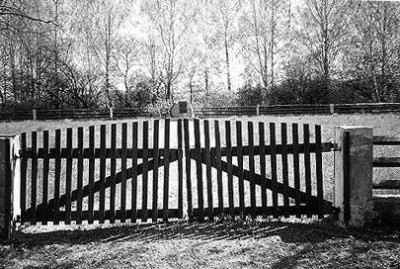
Entrance gate and monument in the background of the mass graves in Lazdey
Photo taken by Ruth ben David
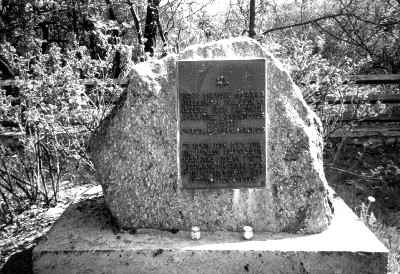
The monument on the mass graves
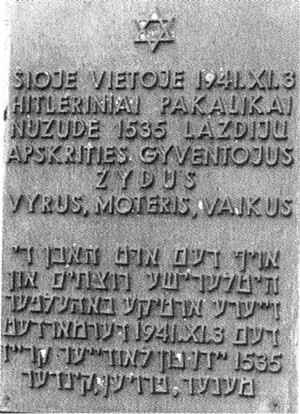
“Here the Hitlerist murderers and their local helpers at Nov. 3, 1941 murdered 1535 Jews from Lazdey district men, women, children.”
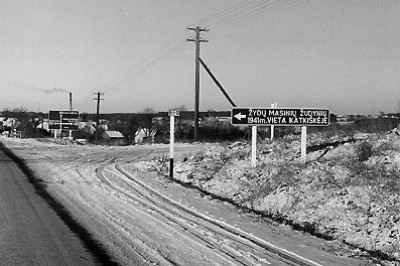
The Fridkovsky sisters survived thanks to two Lithuanian peasants, Zharnauskas and Levulis. After the German retreat they were murdered by Lithuanian nationalists for saving the Jewish girls.
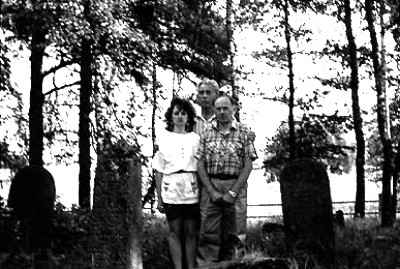
Fulgentas Luvelis and his daughter Nida – the son and granddaughter of the murdered savior of the Fridkovsky sisters at the Jewish cemetery in Kopcheve. Behind is them Yehudah Fridkovsky.
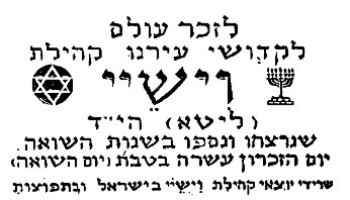
Tablet in remembrance of Vishey Community at the Holocaust Cellar on Mount Zion in Jerusalem
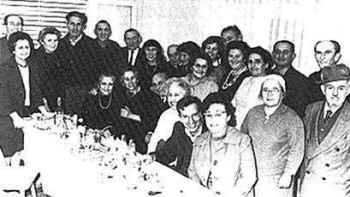
A meeting of former Vishey'ers in Israel
Yad Vashem Archives: Koniuchovsky Collection 0–71, Files 131
YIVO, NY, Collection of Jewish Communities in Lithuania, Files 361–366
Gotlib. Ohalei Shem, (Hebrew) page 64.
Eliezer Peltin, Sipur Khayai (Story of my life) (Hebrew) Private edition 1996
HaMeilitz (St. Petersburg) (Hebrew): 30.1.1893
Folksblat, Kovno (Yiddish): 24.12.1935; 25.4.1939; 30.5.1939; 17.11.1940
Dzuku Zinios–(Lithuanian) Article of Yosif Levinson “Once there were Jews in Veisiejai”18.1.1992; 23.1.1992; 1.8.1992
Jerusalem of Lithuania. No.7(58), October 1995. Article of Yosif Levinson
Antanas Pupienis, Po Dzukijos dangumi (Under the Sky of Dzukija) (Lithuanian).
Valstybines Leidybos Centras. Vilnius 1996
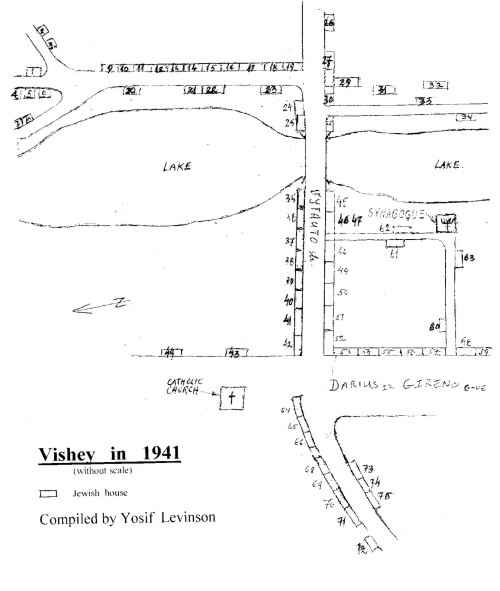
Map and List of Vishey Jewish Families according to the Houses they lived in
(submitted by Yosif Levinson)
of fulfilling our mission of disseminating information about the Holocaust and destroyed Jewish communities.
This material may not be copied, sold or bartered without permission of the copyright holders: Josef Rosin z”l and Joel Alpert.
JewishGen is not responsible for inaccuracies or omissions in the original work and cannot rewrite or edit the text to correct inaccuracies and/or omissions.
Our mission is to produce a translation of the original work and we cannot verify the accuracy of statements or alter facts cited.
 Preserving Our Litvak Heritage
Preserving Our Litvak Heritage
 Yizkor Book Project
Yizkor Book Project
 JewishGen Home Page
JewishGen Home Page
Yizkor Book Director, Lance Ackerfeld
This web page created by Jason Hallgarten
Updated 26 Feb 2023 by LA